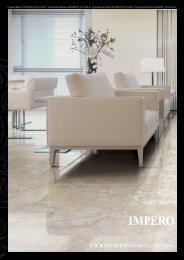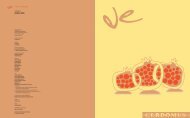Create successful ePaper yourself
Turn your PDF publications into a flip-book with our unique Google optimized e-Paper software.
ANTICO “ MONUMENTO” SEMOVENTE<br />
DEDICATO ALLA FATICA<br />
Il plaustro romagnolo<br />
solo da adulto ho sentito per la prima volta<br />
chiamare “plaustro” - un termine preso pari<br />
pari dal plaustrum latino - quello che per<br />
tutti, una volta, era solo e’ car,<br />
il “carro”.<br />
I Sensi <strong>di</strong> <strong>Romagna</strong><br />
E la maestra riconosciuta da tutti fu Maddalena Venturi <strong>di</strong> Granarolo Faentino, morta nel 1935. A Granarolo, vera capitale<br />
romagnola del “carro”, vi erano e lavoravano anche delle autentiche <strong>di</strong>nastie <strong>di</strong> “carradori”. Qui, naturalmente, parlo del<br />
classico “carro” romagnolo, un attrezzo che in altre regioni, anche per ragioni geografiche, era del tutto sconosciuto.<br />
I colori erano vivacissimi, le ruote e i mozzi <strong>di</strong> un rosso scarlatto. Rosse anche le altre parti, ma tutte decorate <strong>di</strong> <strong>di</strong>segni<br />
bianchi, ver<strong>di</strong>, turchini, gialli che rappresentavano fiori, rami, foglie, festoni. Poi, in quegli autentici capolavori che furono i<br />
“carri” <strong>di</strong> Maddalena Venturi, c’erano, immancabili, tre figure <strong>di</strong> santi. Nel paratoio davanti, dentro a un cerchio, la figura<br />
bonariamente barbuta <strong>di</strong> Sant’Antonio abate, veneratissimo perché era considerato il grande protettore della campagna,<br />
delle bestie domestiche e dei lavori agricoli. Invece, nel paratoio posteriore, in alto, sempre dentro a un cerchio, era <strong>di</strong>pinta<br />
l’immagine della Madonna delle Grazie che teneva nelle mani due fasci <strong>di</strong> frecce spezzate. E poi, al centro in basso, il<br />
pezzo più straor<strong>di</strong>nario: un giovane San Giorgio con l’elmo, sul cavallo impennato, che trafiggeva il drago sottostante.<br />
Il “carro” romagnolo, pesante e lento, è il vero simbolo <strong>di</strong> un’epoca in cui la fatica e il tempo non avevano nessun limite.<br />
THE ROMAGNOL PLAUSTRO<br />
a moving monument to the toils of country life<br />
[14<br />
Not until I was an adult <strong>di</strong>d I first hear the word plaustro – a term derived <strong>di</strong>rectly from the Latin plaustrum –<br />
used to describe something once known by everyone as e’ car, “the cart”.<br />
15]<br />
giuliano bettoli<br />
immagini: archivio giuliano bettoli<br />
Ne vedevo passare, <strong>di</strong> carri, anche in città, non solo in campagna, tirati da due o da quattro buoi.<br />
Ne vedevo mentre li costruivano, perché nel Borgo Durbecco <strong>di</strong> Faenza, dove ho sempre abitato,<br />
anni fa c’erano dei famosi “carradori”: i Grilli, detti “i Biundì”. E lavoravano all’aperto, lungo l’antica via<br />
Emilia. Il “carro” era il più imponente e il più importante degli attrezzi che il conta<strong>di</strong>no usava per i suoi<br />
faticosi lavori. Una famiglia <strong>di</strong> campagna senza il “carro” era considerata una famiglia <strong>di</strong> <strong>di</strong>sgraziati.<br />
Nei gran<strong>di</strong> poderi ce n’erano ad<strong>di</strong>rittura due. Per il trasporto del fieno, della canapa, del grano, dell’uva,<br />
del mosto dentro alle lunghe botti dette “castlé”, della legna; per trasportare i mobili, quando la famiglia<br />
si trasferiva: sempre il “carro” era il mezzo sicuro per questi servizi. Quattro ruote <strong>di</strong> legno cerchiate<br />
<strong>di</strong> ferro, un lungo timone ligneo, nel quale si infilavano le famosissime cavèie <strong>di</strong> ferro col giogo (ve<strong>di</strong><br />
ee N° 15), il pianale del carro poteva arrivare a tre metri <strong>di</strong> lunghezza, ma non è possibile descrivere<br />
in breve tutte le parti dettagliate che lo componevano. Il “carro” dava il senso del monumentale e<br />
del pittoresco. Perché, dopo che i carradori lo avevano creato, <strong>di</strong>ventava come una grande tela<br />
per i “<strong>di</strong>pintori” - più <strong>di</strong> verniciatori, meno <strong>di</strong> pittori - che decoravano il carro con incre<strong>di</strong>bile arte.<br />
As a child I’d see these oxcarts in the town as well as the country, drawn by two or four oxen. I saw them being built too, as my home town of<br />
Borgo Durbecco, where I’ve always lived, was once famous for its cartmaking family: the Grilli, known in the <strong>di</strong>alect as Biundì. They worked<br />
in the open air, on via Emilia. These oxcarts were the biggest and most important accoutrements of the labours of the peasants. A country<br />
family without an oxcart was seen as a wretched family. Some larger farmsteads even had two carts. They were used for transporting hay,<br />
hemp, wheat, grapes, grape must (which was carried in long barrels known as castlé) and firewood; and if the family had to move home their<br />
oxcart was the perfect vehicle for carrying their furniture. Four wooden wheels with iron rims, a long wooden shaft pinned to the yoke by<br />
the characteristic caveja (see ee issue no. 15), and a platform up to three metres long – these were the essential features. They were both<br />
picturesque and monumental in their visual effect. For once the cartmakers had built them, they became a canvas for the <strong>di</strong>pintori – painters<br />
in both senses of the word, although the artistic sense prevails – who decorated them with amazing skill. Recognized as best painter of all was<br />
Maddalena Venturi of Granarolo Faentino, who <strong>di</strong>ed in 1935. Granarolo was a major Romagnol centre of cartmaking where whole dynasties of<br />
cartmakers lived and worked. I’m talking here of the classic Romagnol carro, a vehicle which was completely unknown in other regions, for<br />
geographic and other reasons. It was painted in gaudy colours, the wheels and axes in scarlet, the other parts with a scarlet ground overlaid with<br />
designs in white, green, turquoise and yellow, representing flowers, tendrils, leaves and festoons. The masterpieces produced by Maddalena<br />
Venturi also featured her trademark devotional paintings. On the front panel, inside a circle, was a bearded and affable St. Anthony, especially<br />
venerated by peasants as the patron of the countryside, domestic animals and agricultural work. On the top of the rear panel, again inscribed<br />
within a circle, was the image of Our Lady of Graces, hol<strong>di</strong>ng two bundles of broken arrows in her hands. Below, in the centre, was the most<br />
extraor<strong>di</strong>nary feature: a young St. George in helmet, mounted on a rearing horse, slaying the dragon. That was the Romagnol carro – heavy and<br />
slow, and the perfect symbol of a period when the toils of the peasantry were as long as the days.<br />
Chi non vuole far fatiche, il terreno gli produce ortiche.<br />
Proverbio popolare<br />
STORIA
















